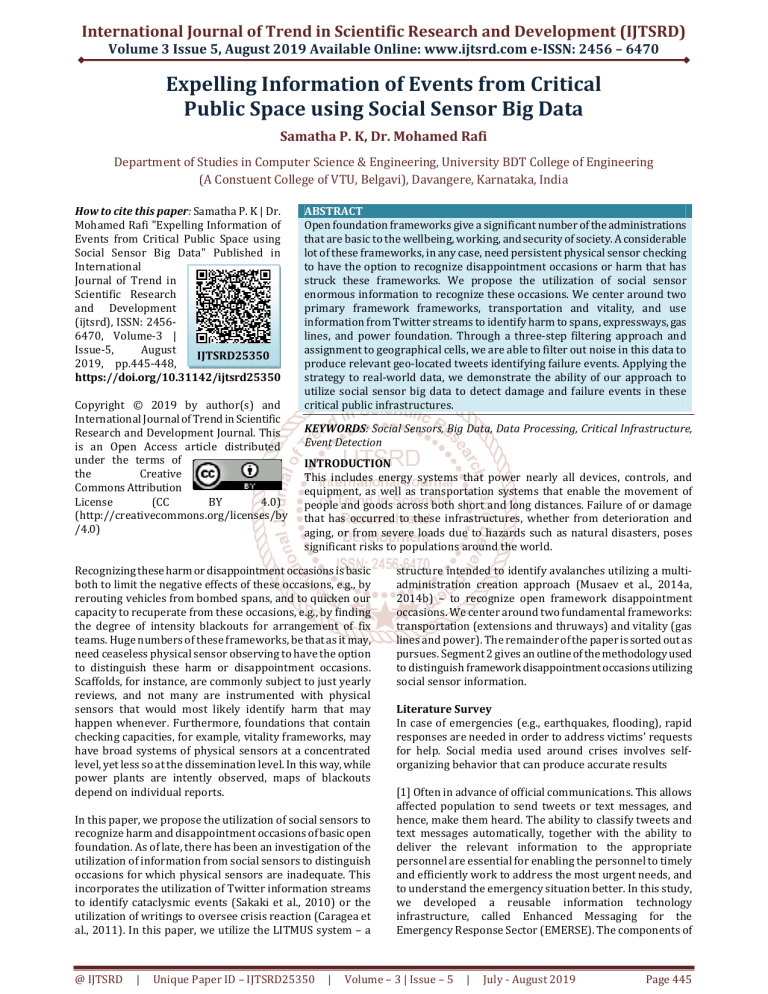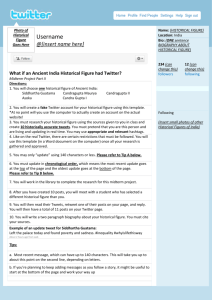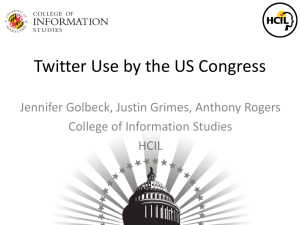
International Journal of Trend in Scientific Research and Development (IJTSRD)
Volume 3 Issue 5, August 2019 Available Online: www.ijtsrd.com e-ISSN: 2456 – 6470
Expelling Information of Events from Critical
Public Space using Social Sensor Big Data
Samatha P. K, Dr. Mohamed Rafi
Department of Studies in Computer Science & Engineering, University BDT College of Engineering
(A Constuent College of VTU, Belgavi), Davangere, Karnataka, India
How to cite this paper: Samatha P. K | Dr.
Mohamed Rafi "Expelling Information of
Events from Critical Public Space using
Social Sensor Big Data" Published in
International
Journal of Trend in
Scientific Research
and Development
(ijtsrd), ISSN: 24566470, Volume-3 |
Issue-5,
August
IJTSRD25350
2019, pp.445-448,
https://doi.org/10.31142/ijtsrd25350
Copyright © 2019 by author(s) and
International Journal of Trend in Scientific
Research and Development Journal. This
is an Open Access article distributed
under the terms of
the
Creative
Commons Attribution
License
(CC
BY
4.0)
(http://creativecommons.org/licenses/by
/4.0)
ABSTRACT
Open foundation frameworks give a significant number of the administrations
that are basic to the wellbeing, working, and security of society. A considerable
lot of these frameworks, in any case, need persistent physical sensor checking
to have the option to recognize disappointment occasions or harm that has
struck these frameworks. We propose the utilization of social sensor
enormous information to recognize these occasions. We center around two
primary framework frameworks, transportation and vitality, and use
information from Twitter streams to identify harm to spans, expressways, gas
lines, and power foundation. Through a three-step filtering approach and
assignment to geographical cells, we are able to filter out noise in this data to
produce relevant geo-located tweets identifying failure events. Applying the
strategy to real-world data, we demonstrate the ability of our approach to
utilize social sensor big data to detect damage and failure events in these
critical public infrastructures.
KEYWORDS: Social Sensors, Big Data, Data Processing, Critical Infrastructure,
Event Detection
INTRODUCTION
This includes energy systems that power nearly all devices, controls, and
equipment, as well as transportation systems that enable the movement of
people and goods across both short and long distances. Failure of or damage
that has occurred to these infrastructures, whether from deterioration and
aging, or from severe loads due to hazards such as natural disasters, poses
significant risks to populations around the world.
Recognizing these harm or disappointment occasions is basic
both to limit the negative effects of these occasions, e.g., by
rerouting vehicles from bombed spans, and to quicken our
capacity to recuperate from these occasions, e.g., by finding
the degree of intensity blackouts for arrangement of fix
teams. Huge numbers of these frameworks, be that as it may,
need ceaseless physical sensor observing to have the option
to distinguish these harm or disappointment occasions.
Scaffolds, for instance, are commonly subject to just yearly
reviews, and not many are instrumented with physical
sensors that would most likely identify harm that may
happen whenever. Furthermore, foundations that contain
checking capacities, for example, vitality frameworks, may
have broad systems of physical sensors at a concentrated
level, yet less so at the dissemination level. In this way, while
power plants are intently observed, maps of blackouts
depend on individual reports.
In this paper, we propose the utilization of social sensors to
recognize harm and disappointment occasions of basic open
foundation. As of late, there has been an investigation of the
utilization of information from social sensors to distinguish
occasions for which physical sensors are inadequate. This
incorporates the utilization of Twitter information streams
to identify cataclysmic events (Sakaki et al., 2010) or the
utilization of writings to oversee crisis reaction (Caragea et
al., 2011). In this paper, we utilize the LITMUS system – a
@ IJTSRD
|
Unique Paper ID – IJTSRD25350
|
structure intended to identify avalanches utilizing a multiadministration creation approach (Musaev et al., 2014a,
2014b) – to recognize open framework disappointment
occasions. We center around two fundamental frameworks:
transportation (extensions and thruways) and vitality (gas
lines and power). The remainder of the paper is sorted out as
pursues. Segment 2 gives an outline of the methodology used
to distinguish framework disappointment occasions utilizing
social sensor information.
Literature Survey
In case of emergencies (e.g., earthquakes, flooding), rapid
responses are needed in order to address victims’ requests
for help. Social media used around crises involves selforganizing behavior that can produce accurate results
[1] Often in advance of official communications. This allows
affected population to send tweets or text messages, and
hence, make them heard. The ability to classify tweets and
text messages automatically, together with the ability to
deliver the relevant information to the appropriate
personnel are essential for enabling the personnel to timely
and efficiently work to address the most urgent needs, and
to understand the emergency situation better. In this study,
we developed a reusable information technology
infrastructure, called Enhanced Messaging for the
Emergency Response Sector (EMERSE). The components of
Volume – 3 | Issue – 5
|
July - August 2019
Page 445
International Journal of Trend in Scientific Research and Development (IJTSRD) @ www.ijtsrd.com eISSN: 2456-6470
EMERSE are: (i) an iPhone application; (ii) a Twitter crawler
component; (iii) machine translation; and (iv) Automatic
message classification. While each component is important
in itself and deserves a detailed analysis, in this paper we
focused on the automatic classification component, which
classifies and aggregates tweets and text messages about the
Haiti disaster relief so that they can be easily accessed by
non-governmental organizations, relief workers, people in
Haiti, and their friends and families.
behaviors have a real effect on the “locatability” of users, we
performed a simple machine learning experiment to
determine whether we can identify a user’s location by only
looking at what that user tweets. We found that a user’s
country and state can in fact be determined easily with
decent accuracy, indicating that users implicitly reveal
location information, with or without realizing it.
Implications for location-based services and privacy are
discussed
They propose and evaluate a probabilistic frame work
[2] For estimating a Twitter user’s city-level location based
purely on the content of the user’s tweets, even in the
absence of any other geospatial cues. By augmenting the
massive human-powered sensing capabilities of Twitter and
related micro blogging services with content-derived
location information, this framework can overcome the
sparsity of geoenabled features in these services and enable
new location based personalized information services, the
targeting of regional advertisements, and so on. Three of the
key features of the proposed approach are:
Micro blogging sites such as Twitter can play a vital role in
spreading information during “natural” or man-made
disasters
(i)its reliance purely on tweet content, meaning no need for
user IP information, private login information, or external
knowledge bases; (ii) a classification component for
automatically identifying words in tweets with a strong local
geo-scope; and (iii) a lattice-based neighborhood smoothing
model for refining a user’s location estimate. The system
estimates k possible locations for each user in descending
order of confidence. On average we find that the location
estimates converge quickly (needing just 100s of tweets),
placing 51% of Twitter users within 100 miles of their actual
location
People in the locality of earthquakes are publishing
anecdotal information about the shaking within seconds of
their occurrences via social network technologies, such as
Twitter. In contrast, depending on the size and location of
the earthquake, scientific alerts can take between two to
twenty minutes to publish. We describe TED (Twitter
Earthquake Detector)
[5] But the volume and velocity of tweets posted during
crises today tend to be extremely high, making it hard for
disaster-affected communities and professional emergency
responders to process the information in a timely manner.
Furthermore, posts tend to vary highly in terms of their
subjects and usefulness; from messages that are entirely offtopic or personal in nature, to messages containing critical
information that augments situational awareness. Finding
actionable information can accelerate disaster response and
alleviate both property and human losses. In this paper, we
describe automatic methods for extracting information from
micro blog posts. Specifically, we focus on extracting
valuable “information nuggets”, brief, self-contained
information items relevant to disaster response. Our
methods leverage machine learning methods for classifying
posts and information extraction. Our results, validated over
one large disaster-related dataset, reveal that a careful
design can yield an effective system, paving the way for more
sophisticated data analysis and visualization systems
Methodology
An overview of the approach is shown in Figure 1. The
sensor data source is Twitter. For the results presented in
this paper, these are tweets pulled over the period of one
month.
[3] A system that adopts social network technologies to
augment earthquake response products and the delivery of
hazard information. The TED system analyzes data from
these social networks for multiple purposes: 1) to integrate
citizen reports of earthquakes with corresponding scientific
reports 2) to infer the public level of interest in an
earthquake for tailoring outputs disseminated via social
network technologies and 3) to explore the possibility of
rapid detection of a probable earthquake, within seconds of
its occurrence, helping to fill the gap between the earthquake
origin time and the presence of quantitative scientific data.
Little research exists on one of the most common, oldest, and
most utilized forms of online social geographic information
[4] The “location” field found in most virtual community user
profiles. We performed the first in-depth study of user
behavior with regard to the location field in Twitter user
profiles. We found that 34% of users did not provide real
location information, frequently incorporating fake locations
or sarcastic comments that can fool traditional geographic
information tools. When users did input their location, they
almost never specified it at a scale any more detailed than
their city. In order to determine whether or not natural user
@ IJTSRD
|
Unique Paper ID – IJTSRD25350
|
We use October 2018 as our evaluation period. It is noted
that data from any other time period can be used within this
framework. To detect infrastructure damage or failure
events, all Twitter data is run through a series of filters to
obtain a subset of relevant data. This filtering is done in
three phases. First, we filter by search terms, which we have
developed for various events of interest, e.g., “bridge
collapse” to detect damage to bridge infrastructure. Second,
as social sensor data is often noisy, with items containing the
search terms but unrelated to the event of interest, data is
filtered using stop words. Using a simple exclusion rule
based on the presence of stop words, this filters out the
Volume – 3 | Issue – 5
|
July - August 2019
Page 446
International Journal of Trend in Scientific Research and Development (IJTSRD) @ www.ijtsrd.com eISSN: 2456-6470
irrelevant data. An example for detecting bridge collapses is
the stop word “friendship” that refers to the collapse of a
bridge or connection between two people. Third, data is
filtered based on geolocation. Although most social networks
enable users to geotag their locations, e.g., when they send a
tweet, studies have shown that less than 0.42% of tweets use
this functionality (Cheng et al., 2010). In addition, users may
purposely input incorrect location information in their
Twitter profiles (Hecht et al., 2011). As geolocating tweets is
an important component in being able to identify specific
infrastructure damage events, including their location, the
data must be additionally filtered. In this study, the Stanford
coreNLP toolkit (Manning et al., 2014) is used along with
geocoding (Google, 2016) to geolocate the tweet. This
assigns each filtered tweet to latitude and longitude and
corresponding 2.5-minute by 2.5-minute cell as proposed in
Musaev et al., 2014, based on a grid mapped to the surface of
the Earth. Once all relevant tweets are mapped to their
respective cells, all tweets in a single cell are assessed to
identify the infrastructure damage and failure events. In this
paper, we focus on the results for tweets relating to damage
detection in four infrastructures: bridge, highway, gas line,
and power infrastructure.
Below diagram Refers to the use cases of admin
IMPLEMENTATION
Location of harm and disappointment occasions to open
framework is executed utilizing information mining AI
system, for example, sifting, Decision tree arrangement
procedures. Here we are actualized cooperative separating
procedure to channel on pursuit things dependent on basic
data which is available in the substance of twitter dataset.
Characterization method is utilized to arrange the
recognized sifted component into gathering which are
identified with one another dependent regarding the matter
which we are considered. At that point bunch is going to
frame the gathering of comparative components like on
client's gathering and relies upon subject gathering etc...,
The inspiration for collective separating originates from the
possibility that individuals regularly get the best suggestions
from somebody with tastes like themselves. Cooperative
sifting envelops strategies for coordinating individuals with
comparative interests and making suggestions on this
premise.
Communitarian separating calculations regularly require (1)
clients' dynamic investment, (2) a simple method to speak to
clients' interests, and (3) calculations that can match
individuals with comparative premiums.
Normally, the work process of a community sifting
framework is:
A client communicates his or her inclinations by rating
things (for example books, films or CDs) of the framework.
These appraisals can be seen as an estimated portrayal of the
client's enthusiasm for the relating space. The framework
coordinates this current client's evaluations against other
clients' and finds the general population with most
"comparative" tastes. With comparable clients, the
framework prescribes things that the comparative clients
have evaluated exceedingly yet not yet being appraised by
this client (apparently the nonattendance of rating is
frequently considered as the newness of a thing).
@ IJTSRD
|
Unique Paper ID – IJTSRD25350
|
Characterization is strategy to order our information into an
ideal and particular number of classes where we can allocate
name to each class. Here are utilized choice tree grouping
method to settle on choice on accessible information things
and characterize them as indicated by basic data. Choice
Tree is easy to comprehend and envision, requires little
information planning, and can deal with both numerical and
all out information.
Iterative Model
In the HITS method, a link is used to represent the
hyperlinks between web pages. Inour TD-HITS method,
however, a link represents an operational relationship
between a user and a post, such as publishing or
commenting. For example, given a post in an undirected
Name
Input
Output
Display data
content
Error message
if entered data
is invalid.
Display data in
Proper format
For further
processing
Select data
file
Browsing
data file
Analyze
Selected
data set
File
Find out
properties/
attributes
Formatted
Data
Attribute list
Processing
Queries
Data
Attributes
E
Query Result E
Remarks
Success
Success
Success
fully show
formatted
data
All
attributes
list
Query
Result E
Test Case: Admin
Network setundirect edges between posts, the n posts and
their connections are interpreted Recorded to construct a
matrix, denoted as A, to maintain the links between the user
and his/her posts. Rows of A denote posts, and of A columns
denote users. As shown in Fig. , the TD-HITS method creates
direct link between users and their posts, with regard to the
corresponding individual user’s operations. In addition, in
this project, we extend the HITS algorithm to exploit the
inseparable connection between users and their
corresponding posts for the purpose of extracting only highquality posts and influential users.
RESULT
Result on the studies is carried out with large number of data
set collected from twitter dataset. Classification is done on
the dataset with filtering resulting in different categories f
data is available on different subjects .Here some of critical
terms are considered like Bridges, Transports, Gas links like
this we are considered a dataset processed according
Volume – 3 | Issue – 5
|
July - August 2019
Page 447
International Journal of Trend in Scientific Research and Development (IJTSRD) @ www.ijtsrd.com eISSN: 2456-6470
requirements and resulted in 98 percent accuracy using
machine learning technique.
Example of bridges gases and sports of datasets categorized.
Fig1: Home Screen
and man-made disasters and to recover more quickly and
efficiently from the negative effects of these hazards. As
many of our public infrastructure systems are not physically
monitored to the degree necessary to provide relevant,
detailed information about the states of these systems in real
time, social sensor data is used to perform this assessment
and detect damage events. In this paper, we describe an
approach to use social sensor big data to identify public
infrastructure damage events. This includes a three step
filtering approach, whereby data is first filtered using search
terms relevant to the event of interest. Next, noise in the data
is filtered out using an exclusion rule based on the presence
of stop words. Finally, data is filtered based on geolocation,
resulting in each relevant filtered data item being assigned to
a 2.5-minute by 2.5-minute cell in a grid mapped to the
surface of the Earth.
REFERENCES
[1] Caragea, C., McNeese, N., Jaiswal, A., Traylor, G., Kim, H.,
Mitra, P., Wu, D., Tapia, A.H., Giles, L., Jansen, B.J., Yen, J.,
2011. Classifying text messages for the Haiti
earthquake. In ISCRAM ’11, Lisbon, Portugal.
Fig2: Analyzing the Dataset based on Categories
[2] Cheng, Z., Caverlee, J., Lee, K., 2010. You are where you
tweet: A content-based approach to geo-locating
Twitter users. In CIKM’10, Toronto, Canada. Google,
https://developers.google.com/maps/documentation/
geocoding/intro, accessed on 2/5/2016.
[3] Guy, M., Earle, P., Ostrum, C., Gruchalla, K., Horvath, S.,
2010. Integration and dissemination of citizen reported
and seismically derived earthquake information via
social network technologies. In IDA’10, Tuscon,
Arizona.
Fig3: Analyzed Data based On User Categories
[4] Hecht, B., Hong, L., Suh, B., Chi, E.H., 2011. Tweets from
Justin Bieber’s heart: The dynamics of the “location”
field in user profiles. In CHI ’11, Vancouver, Canada.
CONCLUSION
Detection of damage and failure events to public
infrastructure is critical to the ability of communities around
the world to minimize the risks associated with both natural
[5] Imran, M., Elbassuoni, S., Castillo, C., Diaz, F., Meier, P.,
2013. Extracting information nuggets from disaster
related messages in social media. In ISCRAM ’13,
Baden-Baden, Germany.
@ IJTSRD
|
Unique Paper ID – IJTSRD25350
|
Volume – 3 | Issue – 5
|
July - August 2019
Page 448








